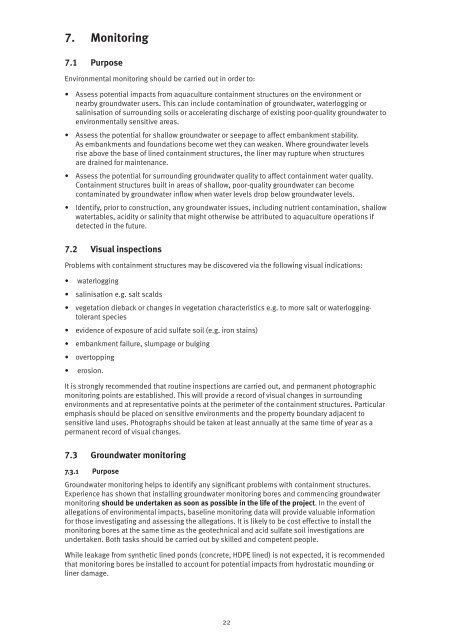Guidelines for constructing and maintaining aquaculture ...
Guidelines for constructing and maintaining aquaculture ...
Guidelines for constructing and maintaining aquaculture ...
You also want an ePaper? Increase the reach of your titles
YUMPU automatically turns print PDFs into web optimized ePapers that Google loves.
7. Monitoring<br />
7.1 Purpose<br />
Environmental monitoring should be carried out in order to:<br />
• Assess potential impacts from <strong>aquaculture</strong> containment structures on the environment or<br />
nearby groundwater users. This can include contamination of groundwater, waterlogging or<br />
salinisation of surrounding soils or accelerating discharge of existing poor-quality groundwater to<br />
environmentally sensitive areas.<br />
• Assess the potential <strong>for</strong> shallow groundwater or seepage to affect embankment stability.<br />
As embankments <strong>and</strong> foundations become wet they can weaken. Where groundwater levels<br />
rise above the base of lined containment structures, the liner may rupture when structures<br />
are drained <strong>for</strong> maintenance.<br />
• Assess the potential <strong>for</strong> surrounding groundwater quality to affect containment water quality.<br />
Containment structures built in areas of shallow, poor-quality groundwater can become<br />
contaminated by groundwater inflow when water levels drop below groundwater levels.<br />
• Identify, prior to construction, any groundwater issues, including nutrient contamination, shallow<br />
watertables, acidity or salinity that might otherwise be attributed to <strong>aquaculture</strong> operations if<br />
detected in the future.<br />
7.2 Visual inspections<br />
Problems with containment structures may be discovered via the following visual indications:<br />
• waterlogging<br />
• salinisation e.g. salt scalds<br />
• vegetation dieback or changes in vegetation characteristics e.g. to more salt or waterloggingtolerant<br />
species<br />
• evidence of exposure of acid sulfate soil (e.g. iron stains)<br />
• embankment failure, slumpage or bulging<br />
• overtopping<br />
• erosion.<br />
It is strongly recommended that routine inspections are carried out, <strong>and</strong> permanent photographic<br />
monitoring points are established. This will provide a record of visual changes in surrounding<br />
environments <strong>and</strong> at representative points at the perimeter of the containment structures. Particular<br />
emphasis should be placed on sensitive environments <strong>and</strong> the property boundary adjacent to<br />
sensitive l<strong>and</strong> uses. Photographs should be taken at least annually at the same time of year as a<br />
permanent record of visual changes.<br />
7.3 Groundwater monitoring<br />
7.3.1 Purpose<br />
Groundwater monitoring helps to identify any significant problems with containment structures.<br />
Experience has shown that installing groundwater monitoring bores <strong>and</strong> commencing groundwater<br />
monitoring should be undertaken as soon as possible in the life of the project. In the event of<br />
allegations of environmental impacts, baseline monitoring data will provide valuable in<strong>for</strong>mation<br />
<strong>for</strong> those investigating <strong>and</strong> assessing the allegations. It is likely to be cost effective to install the<br />
monitoring bores at the same time as the geotechnical <strong>and</strong> acid sulfate soil investigations are<br />
undertaken. Both tasks should be carried out by skilled <strong>and</strong> competent people.<br />
While leakage from synthetic lined ponds (concrete, HDPE lined) is not expected, it is recommended<br />
that monitoring bores be installed to account <strong>for</strong> potential impacts from hydrostatic mounding or<br />
liner damage.<br />
22

















